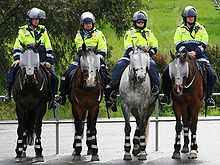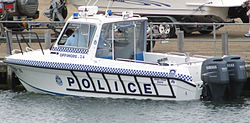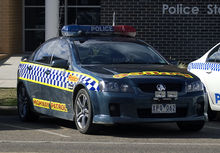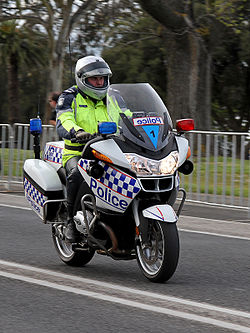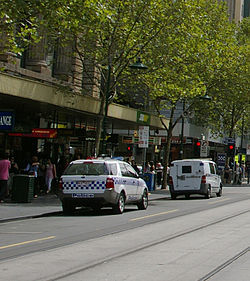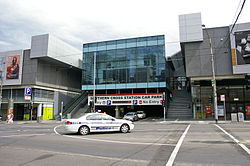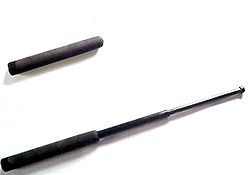- Victoria Police
-
- For the Canadian Force see: Victoria Police Department
Victoria Police Logo of the Victoria Police. Motto Uphold the Right
Originally written in French as "Tenez le Droit"Agency overview Formed 8 January, 1853 Employees 15,555 (June 2011)[1] Annual budget AUD $1,972.5 million (2010–11)[1] Legal personality Governmental: Government agency Jurisdictional structure Operations jurisdiction* State of Victoria, Australia Governing body Government of Victoria Constituting instrument Police Regulation Act 1958 General nature Operational structure Overviewed by Office of Police Integrity Headquarters Victoria Police Centre
637 Flinders Street,
Melbourne, VIC 3005
37°49′08″S 144°57′45″E / 37.8189°S 144.9624°ECoordinates: 37°49′08″S 144°57′45″E / 37.8189°S 144.9624°ESworn members 12,193 (June 2011)[1] Minister responsible Peter Ryan, Minister for Police Agency executive Ken Lay, Chief Commissioner Units List- Air Wing
- Arson & Explosives Squad
- Criminal Investigation Unit
- Divisional Intelligence Unit
- Dog Squad
- Drug Task Force
- Force Response Unit
- Forensic Services Department
- Homicide Squad
- Mounted Branch
- Operations Response Unit
- Organised Motor Vehicle Theft Squad
- Regional Response Unit
- Search and Rescue Squad
- Sexual Offences & Child Abuse Unit
- Special Operations Group
- Traffic Management Unit
- Water Police
Regions Western, Eastern, North West Metro, Southern Metro[2] Facilities Stations 393[2] Website police.vic.gov.au Footnotes * Divisional agency: Division of the country, over which the agency has usual operational jurisdiction. Victoria Police is the primary law enforcement agency of Victoria, Australia. As of 2011[update], the Victoria Police has over 12,190 sworn members, along with over 400 recruits, reservists and Protective Service Officers, and over 2,900[3] civilian staff across 393 police stations.
Contents
History
Early history
The Victoria Police was formally established on 8 January 1853 from an existing colonial police force of 875 men. The first appointment as Chief Commissioner was William Henry Fancourt Mitchell.
Their first major engagement was the following year, 1854, in support of British soldiers during the events leading up to, and confrontation at, the Eureka Stockade where some miners (mostly Irish), police and soldiers were killed[citation needed]. Following the brutality of the police after the stockade, public opinion turned against them, the 13 miners charged with treason were all acquitted and police numbers were dramatically cut[citation needed].
A new Chief Commissioner, Charles MacMahon, was appointed that same year. The first death in the line of duty, that of Constable William Hogan, also occurred in 1854.
The following couple of decades saw the growth of the police force, including the beginning of construction of the Russell Street police station in 1859 and the establishment of a special station in William Street to protect the Royal Mint in 1872.
 Mounted police outside the Sarah Sands Hotel in Brunswick awaiting a march by the unemployed in 1893.
Mounted police outside the Sarah Sands Hotel in Brunswick awaiting a march by the unemployed in 1893.
Six years later, three more officers (Kennedy, Lonigan and Scanlan) who were hunting the Kelly Gang, were killed by them at Stringybark Creek. Two years later, in 1880, the police confronted the Kelly Gang at Glenrowan. A shoot-out ensued on 28 June, during which three members of the Kelly Gang were killed and following which Ned Kelly was shot and captured.
1880 also saw the formation of the Aboriginal Tracker Corps. The corps was disbanded in 1968.
In 1888 Senior Constable John Barry produced the first Victoria Police Guide, a manual for officers. (The Victoria Police Manual, as it is now known, remains the comprehensive guide to procedure in the Victoria Police.) Police officers were granted the right to vote in parliamentary elections the same year.
In 1899 the force introduced the Victoria Police Valour Award to recognise the bravery of members. Three years later, in 1902, the right to a police pension was revoked.
1923 Victorian Police strike
On 31 October 1923 members of the Victoria Police Force refused duty and went on strike over the introduction of a new supervisory system. The police strike led to riots and looting in Melbourne's central business district. The Victorian government enlisted Special Constables, and the Commonwealth of Australia called out the Australian military. Victoria Police are the only Australian police department to ever go on strike.
Only a few of the strikers were ever employed as policemen again, but the government increased pay and conditions for police as a result. Members of the Victoria Police (as its officers are generally known) now have among the highest union membership rates of any occupation, at well over 90%. The Victorian police union, the Police Association, remains a very powerful industrial and political force in Victoria.
Recent history – controversy and corruption allegations
In the 1980s and 1990s allegations were made against most Australian police forces of corruption and graft, culminating in the establishment of several Royal Commissions and anti-corruption watchdogs. Inquiries have also been held into Victoria Police (Beach et al.). The force was criticised because members of the public (both innocent and guilty) were being fatally shot at a rate exceeding that of all other Australian police forces combined.[4]
In 2001, Christine Nixon was appointed Chief Commissioner, becoming the first woman to head a police force in Australia.
In addition to allegations of corruption among the Uniformed Members of Victoria Police, allegations also surfaced in respect of senior members of the Civil Service serving in Victoria Police. Two Motions were raised in the Supreme Court of Victoria. One, Motion 5771/2002 alleged that senior members of Victoria Police divulged the name of a senior Victoria Police Whistleblower to the detriment of his safety. The other, Motion 6337/2002 alleged that the Ombudsman's Office and Auditor General's Office in Victoria had falsified evidence and produced a whitewash report into allegations of corruption in relation to several multi-million dollar contracts. For reference, these documents may be viewed at the Prothonotary's Office at the Supreme Court of Victoria in Melbourne.
In June 2003, Taskforce Purana was set up under the command of (then) Assistant Commissioner Simon Overland to investigate Melbourne's "gangland killings".
In May 2004 former police officer Simon Illingworth appeared on Australian Story to tell his disturbing story of entrenched police corruption in Victoria Police. He has also written a book about his experiences entitled Filthy Rat.[5]
In early 2007, Don Stewart, a retired Supreme Court judge, called for a Royal Commission into Victorian police corruption. Stewart alleged that the force was riddled with corruption that the Office of Police Integrity was unable to deal with.[6]
In early February 2009, in response to evidence that many of the 2009 Victorian bushfires were deliberately lit, Chief Commissioner Christine Nixon announced the creation of Taskforce Phoenix to investigate all related deaths during the fires, to be led by Assistant Commissioner Dannye Moloney of the crime department and was composed of around 100 police officers.[7]
On 2 March 2009, Simon Overland was named as the new Chief Commissioner, replacing Christine Nixon, who was retiring.[8] Simon Overland prematurely resigned on 16 June 2011.
In November 2011 then Acting Chief Commissioner Ken Lay was named as Chief Commissioner after five months in caretaking.
Rank structure
The Victoria Police is run in a para-military structure. All sworn members start at the lowest rank of Probationary Constable / Constable and work their way up. Confirmed Constables are promoted in situ to Senior Constable after 4 years. Promotion beyond Senior Constable is highly competitive.
Constable & Non-Commissioned Ranks Rank Constable Senior
ConstableLeading
Senior
ConstableSergeant Senior
SergeantInsignia 




Commissioned Ranks Rank Inspector Chief
InspectorSuperintendent Chief
SuperintendentCommander Assistant
CommissionerDeputy
CommissionerChief
CommissionerInsignia 







Non-Commissioned Ranks
Promotion to the Rank of Sergeant and beyond is based upon a "merit based" promotion system. A Sergeant normally manages a team during a shift, like Patrol Supervisor of a district for a shift. A Detective Sergeant is normally in charge of a team in a specific part of either Local Detectives at Police Stations or crime squads.
A Senior Sergeant oversees the Sergeants and traditionally perform more administrative work, coordination of policing operations or specialist work than active patrol duties. They perform middle management duties. General duties Senior Sergeants are traditionally in charge of most police stations or can be a sub-charge (or second in charge) of larger (usually a twenty-four hour) police station. In each Division, or group of divisions on a night shift, a Senior Sergeant is the Division Supervisor for a shift and is responsible for managing and overseeing incidents in their area. Detective Senior Sergeants are usually Officer in Charge of the Crime Investigation Units.
Designations
Additional classifications are available for members skilful enough, and upon completion of certain training and work-based performances, for classification of Detective at Senior Constable level. Detectives also hold classification up to Chief Superintendent.
Devolved Ranks
The ranks of Chief Inspector and Chief Superintendent are no longer promotable ranks, however some officers still hold these ranks.
Positions
It used to be the case that Leading Senior Constable (LSC) is a position listed in the Rank structure but was not a Rank per se. It was only open for Senior Constables to apply for and was not a permanent position. If a member transferred to another duty type or station, the officer was then relieved of the position of LSC. It was primarily a position for Field Training Officers who oversees the training and development of inexperienced Probationary Constables or Constables.
The most recent round of wage negotiations however saw the title of Leading Senior Constable become an actual rank. It is awarded "in situ" but only after assessments have been made against the Senior Constable's ability to move to the higher position. Leading Senior Constables are now capable of being upgraded to Acting Sergeant and it is expected that the position is one that people will move through as they are promoted.
Members who held the position or classification of Leading Senior Constable under the last Enterprise Bargaining Agreements will retain their title and position.
Detective branch
Detectives form an integral function in Victoria Police for the detection and investigation of serious crime. Crimes ranging from Burglaries and major thefts, serious assaults and now, as a result of the reorganisation of the Crime Department, Murder/Suicides are just some of the crimes investigated by Suburban (Divisional) Detectives.
Many major police stations, in places such as Prahran, Fawkner, Broadmeadows, Dandenong, Geelong and Melbourne West have a Crime Investigation Unit attached to the station, which looks after crime within those and other neighbouring sub-districts falling within their area.
The State Crime Squads, situated in St Kilda Road, have been recently realigned and contain a number of squads and mini taskforces responsible for the investigation of major drug trafficking activities, major frauds, Homicides, Armed Robbery and Firearms Trafficking and sex offences to name but a few.
To become a Detective within Victoria Police members must be confirmed Senior Constables, with at least 4 years service, have completed the Field Investigation Course and obtained sufficient experience to sustain the application and interviewing process. Upon obtaining a position at a CIU/Squad, members must then complete the training package (preliminary portfolio of work and course attendance) at the School of Investigation (Detective Training School) to confirm their position as a qualified Detective. Detective positions within Victoria Police are highly sought after and awarded, generally, to only the best police applying.
Traditionally, more experienced detectives cut their teeth at divisions and then moved into the crime squads. However the last 10 years has seen a switch in that progression, in that many junior detectives first obtain positions at the sometimes easier to fill Crime Department positions and then later moving onto divisional work. One major reason for this is the travel and often heavy hours involved in working within Metropolitan Melbourne.
Honours and Awards
Recognition of the bravery and good conduct of Victoria Police employees is shown through the awarding of honours and decorations. Employees (including both sworn and unsworn personnel) are eligible to receive awards both as a part of the Australian Honours System and the internal Victoria Police awards system.[9]
Australian Honours System
Victoria Police Employees, like those of their counterparts in other states police forces, are eligible for awards under the Australian Honours System, including:
- Australian Bravery Decorations,[10] namely the Cross of Valour (CV), Star of Courage (SC), Bravery Medal (BM) and the Commendation for Brave Conduct.
- Australian Police Medal[11] – The Australian Police Medal (APM) recognises distinguished service by a sworn police employee and is awarded on Australia Day and Queen’s Birthday each year;
- Police Overseas Service Medal[12] – The Police Overseas Service Medal (POSM) recognises service by employees of Australian police forces with international peacekeeping organisations;
- Humanitarian Overseas Service Medal[13] – The Humanitarian Overseas Service Medal (HOSM) honours members of recognised Australian groups that perform humanitarian service overseas in hazardous circumstances;
- National Medal[14] – Available to sworn police employees only, the National Medal (NM) is awarded to specified categories of employees from recognised organisations for diligent service and good conduct over a sustained period. Issued for 15 years service with a clasp issued for each additional 10 years of eligible service;
- Public Service Medal[15] – The Public Service Medal (PSM) is awarded for outstanding public service and is awarded on Australia Day and Queen’s Birthday each year;
- Campaign Medals such as United Nations Medal For Service, when seconded or attached to an appropriate United Nations position overseas.
Internal Victoria Police Honours and Awards
- Victoria Police Valour Award – The Victoria Police Valour Award (VA) is awarded to sworn police employees for a particular incident involving an act that displayed exceptional bravery in extremely perilous circumstances;
- Victoria Police Star – The Victoria Police Star is an award for employees killed or seriously injured, on or off duty;
- Victoria Police Medal for Excellence – Awarded to an employee/s who has/have demonstrated a consistent commitment to exceeding the organisational goals and priorities of Victoria Police;
- Victoria Police Medal for Courage – Awarded to an employee/s who has/have performed an act of courage in fulfilment of their duties in dangerous and volatile operational circumstances;
- Victoria Police Medal for Merit – Awarded to an employee/s who has/have demonstrated exemplary service to Victoria Police and the Victorian community;
- Victoria Police Service Medal – The Victoria Police Service Medal (VPSM) is recognition by the Chief Commissioner of the sustained diligent and ethical service of Victoria Police employees. The medal issued for 10 years service with a clasp issued for each further period of 5 years eligible service. Additionally the medal is available to former employees who left Victoria Police prior to the introduction of the VPSM on 26 February 1996;
- Victoria Police Thirty Five Years Service Award – The Thirty Five Years Service Award recognises employees who have an extensive and dedicated employment history with Victoria Police
- Victoria Police Unit or Group Citation for Courage or Merit – As per the Medal for Courage and/or Medal for Merit criteria;
- Victoria Police Department or Regional Commendation – A Department or Regional Commendation provides recognition of exceptional performance or service;
- Victoria Police Divisional Commendation – A Divisional Commendation provides recognition of exceptional performance or exceptional service;
- Victoria Police Unit or Group Commendation – A Unit or Group Commendation can be awarded at Department, Regional or Divisional level;
Firearms and equipment
Officers carry the .38 Special Smith & Wesson Model 10 revolver in K-Frame, containing six copper jacketed, notched, hollow point bullets (147 grain) and one speedloader of spare ammunition (six rounds). It has been in service since 1976.[16] They also carry an ASP brand 21-inch expandable baton, Oleoresin Capsicum (OC) Spray and Hiatts brand handcuffs. The vast majority of officers carry a Motorola brand tactical radio (with or without handpiece). Other divisions of the Victoria Police have speciality equipment and defensive weapons.
Equipment is carried by officers in a nylon equipment belt, also known as a gun or weapon belt. The nylon belt, specifically designed to be very light-weight, was first issued in 2003 as a replacement for worn leather belts. The belt consists of one firearm holster placed on the hip (either side), one speed loader pouch, one ASP (baton) pouch, one OC Spray pouch, one hand cuff pouch and one holder for the portable radio. Other holsters can be added to the belt to suit members duties such as a clip to hold the Polycarbonate Baton or mag light. In 2007/08, the Chief Commissioner approved the issue of firearm holsters which could be strapped around the members thighs, to replace the low-riding belt gun holster. These holsters are not standard issue but are issued to members upon request, and are commonly requested by members who suffer from back aches (as a result of heavy utility belt), or those who find it more operationally sound to draw their firearms from a lower position (as this option offers a more comfortable reach).
The weapons issued to police was a politically contentious issue in the 2006 Victorian state election. A deal between the police union and the state government allocated funding sufficient to cover replacement of the revolvers with semi-automatic pistols, and the equipping of all police cars with tasers, was reached without the involvement of police command.[4] However, despite the allocation of funds in the 2007 state budget, there was initially no indication that the police command had actually decided to purchase the new weapons.[17]
After a violent shootout in Melbourne, during which a man shot a police officer and was shot dead himself, concerns were raised by the Police Association about a possible upgrade to semi-automatic weapons with the $10 million allocated to the police in the 2008–09 Victorian State Budget. Chief Commissioner Christine Nixon launched an inquiry into the fiscal aspect of a possible upgrade. [18]
On 6 June 2008, Chief Commissioner Christine Nixon announced that an external panel, consisting of a County Court Judge, members of the Australian Defence Force, members of the community, an ethicist and "other professionals" advised that Victoria Police should adopt semi-automatic duty firearms. The Chief Commissioner had previously announced that she would accept and implement the recommendations of the external panel. She further stated her concerns in regards to semi-automatic firearms, especially if Members of the Police Force required the additional fire power. She believed that there were no incidents she could foresee where general duties members would require the additional ammunition afforded by a semi-automatic duty firearm. In her statement on the Radio 3AW Melbourne she stated that she would like to see the new firearms begin to be issued in about six months.[19]
On 29 April 2010, it was announced that the .40 Smith & Wesson M&P semi-automatic pistol was selected as the service weapon to replace the existing Smith & Wesson Model 10 revolver.[16] Over 10,000 Victorian Police officers will undergo training and qualification before being issued new pistols.[20]
Officers killed on duty
- 13 July 1979, Detective Senior Constable Robert Lane was shot and killed while performing a routine interview. Lane was the first officer to be slain on duty since the end of the Vietnam War.
- 27 March 1986, Constable Angela Taylor was killed in the Russell Street Bombing. Taylor was the first female police officer killed in the line of duty in Australian history.
- 12 October 1988, officers Steven Tynan and Damian Eyre were gunned down in the Walsh Street police shootings.
- 16 August 1998, officers Gary Silk and Rodney Miller were gunned down in the Silk-Miller police murders.
Memorials to officers killed on duty are maintained at the Chapel of Remembrance within the main Chapel of the Victoria Police Academy at Glen Waverley in the eastern suburbs of Melbourne. There is also a memorial to police officers who have died on duty in Kings Domain, Melbourne.
See also
- Victoria Police Special Operations Group
- Victoria Police Search and Rescue Squad
- Victoria Police Air Wing
- Victoria Police Critical Incident Response Team
- Victoria Police Pipe Band
- Victoria Police Academy
- Corrections Victoria
- Office of Police Integrity
- Project Griffin
- Crime in Melbourne
References
- ^ a b c Victoria Police Annual Report 2010-2011, Victoria Police, 30 June 2011.
- ^ a b Victoria Police Boundaries, Victoria Police. Retrieved 21 October 2010.
- ^ "Careers". Victoria Police. http://police.vic.gov.au/content.asp?Document_ID=5. Retrieved 27 July 2011.
- ^ a b Murphy, Mathew; Petrie, Andrea; Munro, Ian; Tomazin, Farrah (15 November 2006). "New lethal weapons for police". The Age (Melbourne). http://www.theage.com.au/news/vicelection06news/new-lethal-weapons-for-police/2006/11/14/1163266550686.html?page=fullpage#contentSwap1.
- ^ Illingworth, Simon (2006). Filthy Rat : One Man's Stand Against Police Corruption and Melbourne's Gangland War (2nd ed. ed.). Fremantle, W.A.: Fontaine Press. ISBN 9780980417043.
- ^ "Former judge says Vic police are corrupt". The Sydney Morning Herald. 11 January 2007. http://www.smh.com.au/news/National/Former-judge-says-Vic-police-are-corrupt/2007/01/11/1168105079090.html.
- ^ "PM – Arson taskforce searching for suspects". ABC Online. http://www.abc.net.au/pm/content/2008/s2487831.htm. Retrieved 27 July 2011.
- ^ [1][dead link]
- ^ Victoria Police Honours & Awards, Victoria Police. Retrieved 1 December 2010.
- ^ Australian Bravery Decorations, Awards and Culture Branch, Department of Prime Minister and Cabinet. Retrieved 1 December 2010.
- ^ Australian Police Medal, Awards and Culture Branch, Department of Prime Minister and Cabinet. Retrieved 1 December 2010.
- ^ Police Overseas Service Medal, Awards and Culture Branch, Department of Prime Minister and Cabinet. Retrieved 1 December 2010.
- ^ Humanitarian Overseas Service Medal, Awards and Culture Branch, Department of Prime Minister and Cabinet. Retrieved 1 December 2010.
- ^ National Medal, Awards and Culture Branch, Department of Prime Minister and Cabinet. Retrieved 1 December 2010.
- ^ Public Service Medal, Awards and Culture Branch, Department of Prime Minister and Cabinet. Retrieved 1 December 2010.
- ^ a b Millar, Paul (29 April 2010). "Victoria Police switches to semi-automatic weapons". The Age (Melbourne). http://www.theage.com.au/victoria/victoria-police-switches-to-semiautomatic-weapons-20100429-tt44.html.
- ^ "$273m extra to fight crime". Herald Sun. Australian Associated Press. 1 May 2007. http://www.heraldsun.com.au/news/m-extra-to-fight-crime/story-e6frf7jo-1111113448162.
- ^ Davis, Michael (15 May 2008). "Police may get semi-automatic guns after shootout". The Australian (News Limited). http://www.theaustralian.news.com.au/story/0,25197,23702952-2702,00.html. Retrieved 27 July 2011.
- ^ Burgess, Matthew (6 June 2008). "Semi-automatic weapons move a victory, says police union". The Age (Melbourne: Fairfax Digital). http://www.theage.com.au/national/semiautomatic-weapons-move-a-victory-says-police-union-20080606-2mhq.html. Retrieved 27 July 2011.
- ^ "Police award tender for semi-automatic firearms". Victoria Police. 29 April 2010. http://www.vicpolicenews.com.au/more-news/3770-police-award-tender-for-semi-automatic-firearms.html. Retrieved 2010-04-29.[dead link]
External links
- Victoria Police website
- Victoria Police news
- Victoria Police Blue Ribbon Foundation
- Victorian Police Association
Government of Victoria Executive 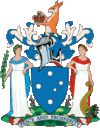
Legislative Parliament • Legislative Council • Legislative Assembly • Electoral regions • Electoral districts • President of the Legislative Council • Speaker of the Legislative Assembly • MLCs • MLAs • Opposition LeaderJudicial Chief Commissioners of Victoria Police Mitchell (1852–1854) · MacMahon (1854–1858) · Standish (1858–1880) · Chomley (1881–1902) · O'Callaghan (1902–1913) · Sainbury (1913–1919) · Steward (1919–1920) · Gellibrand (1920–1922) · Nicholson (1922–1925) · Blamey (1925–1936) · Duncan (1937–1954) · Porter (1955–1963) · Arnold (1963–1969) · Wilby (1969–1971) · Jackson (1971–1977) · Miller (1977–1987) · Glare (1987–1992) · Comrie (1993–2001) · Nixon (2001–2009) · Overland (2009–2011) · Lay (2011–present)Categories:- Law enforcement agencies of Australia
- 1853 establishments in Australia
- Emergency services in Victoria (Australia)
- Law enforcement agencies of Victoria (Australia)
Wikimedia Foundation. 2010.


